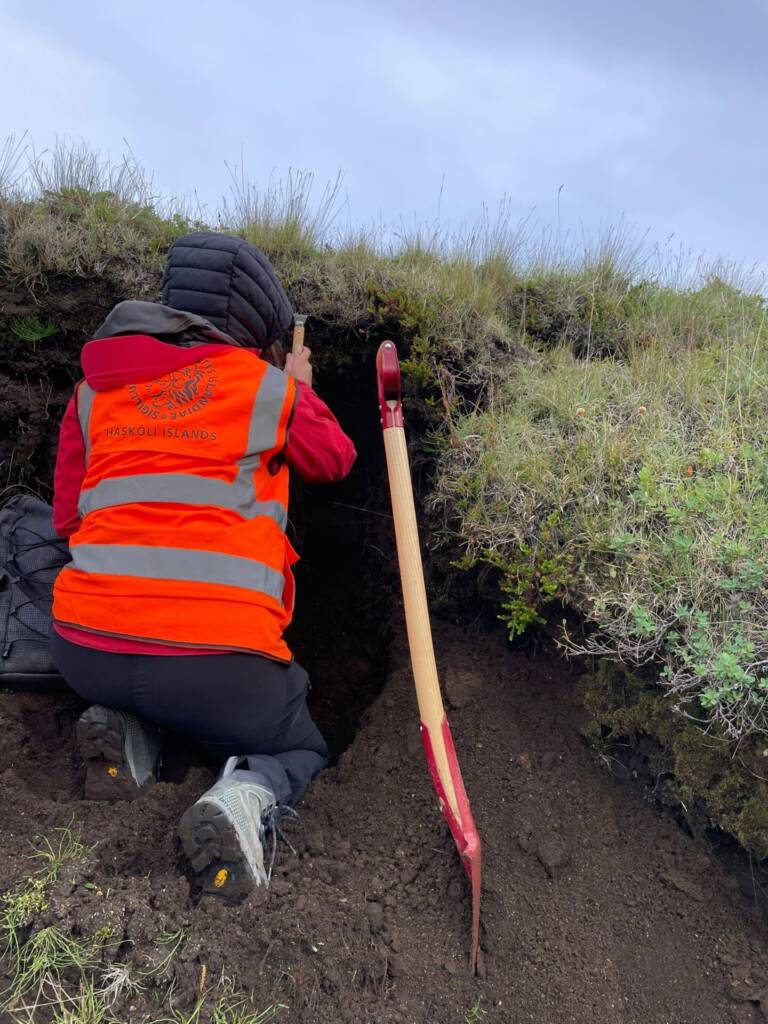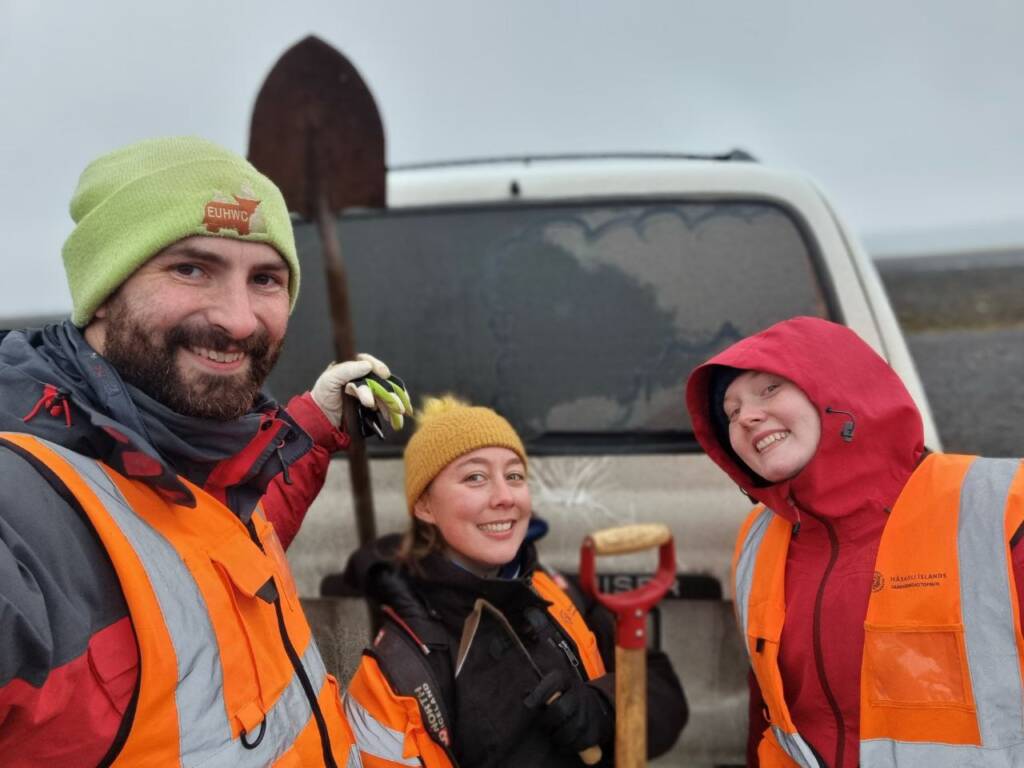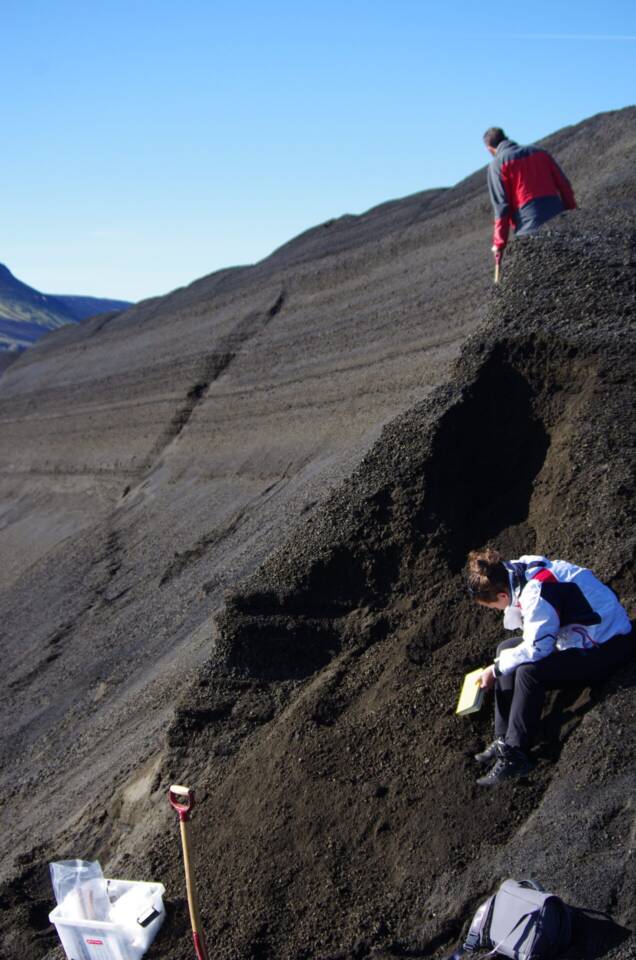Dynamics of Plinian basaltic eruptions from field reconstruction and physical modelling of historical plumes.
Méline Payet--Clerc, doktorsnemi við Háskóla Íslands
Hér segir hún okkur aðeins frá rannsókn sinni sem fjallar um basíska sprengigosið í Veiðivötnum 1477, sem var sprungugos í Veiðivatna-Bárðarbungu eldstöðvakerfinu, en það er stærsta og öflugasta sprengigos sinnar tegundar á Íslandi á sögulegum tíma.
Méline Payet–Clerc, PhD student in Physical Volcanology at the University of Iceland
(Háskóli Íslands) and the Institut de Physique du Globe de Paris, Université de Paris Cité,
received a grant from the Science and Research Fund of South Iceland in 2023 for her
research focusing on the understanding of basaltic explosive eruptions and on modelling
the resulting ash plume from eruptive parameters retrieved from the field.

Brief introduction
My research focuses on the characterizing source parameters for basaltic explosives
eruptions of Plinian intensity. Plinian eruptions can lead to eruptive plumes reaching as
high as 20-50 km. Yet, the current understanding on basaltic magmas physical and
chemical properties does not allow for such explosivity. Thus, the explosivity of these
magmas has been associated to magma-water interactions enhancing explosivity. But
new studies tend to show that such interactions are not always the main drivers of
explosive basaltic eruptions. The fast ascension of the gas present in the magma being
the primary factor. For my project I focus on the basaltic Veiðivötn 1477 CE explosive
eruption that took place in the Southern highlands, being one of the biggest eruption in
Iceland historical times. I try to characterize its source parameters to constrain the
eruptive dynamics from collecting field data and modelling the resulting eruptive plume.
Objective
The aim of this project is to characterize the source parameters and driver of the
Veiðivötn 1477CE explosivity.
Veiðivötn:
Located in the central highlands of Iceland, the South end of the Veiðivötn fissure swarm
extend from the edges of the Torfajökull volcanic system to the Barðarbunga central
volcano. This fissure swarm is known for long crater rows extending to one end to the
other. Studies show that this mafic system can produce lava flows as much as large
explosive events. These mafic explosive events have been associated to the magma ‘s
interaction with the ground water table. The Veiðivötn 1477CE eruption is the youngest
event that took place in the area. This event produced 10km^3 of basaltic tephra,
covering an inland area of about 53,000km^2, with a deposit remaining centimetre thick
more than 250 km away from the source. Thus, it accounts for one of the most powerful
eruptions that has taken place in historical time in Iceland. The eruption can be
considered of Plinian style and occurred along a ~70 km long discontinuous eruptive
fissure, probably associated to a rifting event. The eruptive fissure runs through the
Torfajökull volcanic system. The latter simultaneously erupted and produced silicic
tephra fall associated with emissions of obsidian lava flows. Our study focuses on the
basaltic tephra emitted from the Veiðivötn segment.

The eruptions that should not be:
Eruptions can be classified in two simplified categories: (i) Effusive eruptions creating
lava flows, e.g., Hawaii, Fagradalsfjall, Sundhnúkur, Holuhraun, Réunion Island; (ii)
Explosive eruptions, creating an ash plume rising several kilometres to tens of kilometres
in the atmosphere, spreading ash far away from the source, e.g., Askja, Eyjafjallajökull,
Öræfajökull, Hunga Tunga, Mont Saint Helen. These two eruptions modes are usually
associated with a difference in magma composition. Effusive eruptions are most
associated to basaltic magmas of low gas content and low viscosity, while explosive
eruptions are most associated to more evolved magmatic composition with lower
temperature, higher gas content and greater viscosity. The long withstanding notion is
that the intensity of explosive activity in basaltic explosive eruptions is caused by
explosive interaction with external water (phreatomagmatic). However, new results
indicate that initial fragmentation and the overall eruption intensity are driven by
magmatic gasses (magmatic fragmentation), during an unusual fast ascent of the
magma in the conduit. While the role of the external water is passive and confined to
secondary fragmentation that does not add significantly to the eruption intensity. Also,
recent studies have demonstrated that historical large volume basaltic fissure eruptions
in Iceland (e.g. 1783-4 CE Laki and 934-9 CE Eldgjá) featured both magmatic and
phreatomagmatic explosive phases, reaching up to Plinian intensity. Yet, the
mechanism(s) by which such intensities are acquired in explosive basaltic eruptions is
not fully understood, as according to eruption models the initial viscosity of these
magmas is too low to enable for such a pressurisation withing the shallow conduit
leading to magmatic fragmentation alone.
What do we do:
Our study aims to address the explosive basaltic eruption paradox and to understand the
eruptive plume dynamics and tephra dispersal of Plinian basaltic eruptions, using the
case study of the Veiðivötn 144CE event.
To address these research questions, we use a combination of field data and a one-dimensional physical model of an eruptive plume, i.e., Paris Plume Model (PPM). An
extensive field work campaign covering the full extent of the deposit enabled us to
recover about 84 tephra samples. These samples were used to gather grain size
distribution, density and thickness of the deposit at any given point. Field data are used
to discriminate different eruptive phases and associated dispersals and characterize the
vents dynamics. Field surveys enable us to discriminate different eruptive phases. Some
units can be correlated across the deposit and their axis of dispersal roughly mapped.
We reconstructed the total grain size distribution (TGSD) and characterised the TGSD at
the vent. The later was implemented in the model together with the density of the fine
material and chemistry data retrieved from the literature.
Published model and equation allows us to estimate a maximum plume height of 30km
based on field data. The maximum plume height is linked to the exit velocity of the
mixture at the vent, it‘s volatile content and wind conditions. Thus, the maximum plume
height allows us to estimate the Mass Eruption Rate (MER) and volatile content at the
source for various wind conditions. Together with the eruption duration. We find that the
usual measured volatile content of basaltic magmas emitted by the Veiðivötn fissure
swarm is 2 times lower than the required volatile content able to sustain a rising plume
of 30km in the case of a pure magmatic fragmentation.
Our results indicates that magma-water interaction may have taken place during the
Veiðivötn 1477CE event, yet this process alone is insufficient to account for the whole
explosivity of the event.
What’s next?
Understanding the eruption as a whole was a first step to characterise the scale of the
eruption. In a second time, each unit can be studied on its own to better understand the
dynamics of the eruption, through time. Now, our results push us to look in better details
at the potential magma-water interaction and role in the eruptive dynamics of basaltic
explosive eruptions. Estimating the amount of volatiles present initially in the mama will
provide insights on the magma’s composition and dynamics, while the residual content
can be used to determine how much volatile contributed to the explosivity. As well,
quantifying how much gas was released into the atmosphere allows for estimations of
climatic impacts.
A participatory approach has been implemented, especially with Glacier Adventure company in Hali (Haukur Einarsson), with guides measuring weekly the groundwater level in Hali. Outreach presentations have been done in Nyheimar (Höfn) in October 2023, in Hali in June 2024 and will continue to be done as we get more results and go back to the study site.

Jarðvegurinn geymir mikla sögu.

